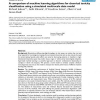Free Online Productivity Tools
i2Speak
i2Symbol
i2OCR
iTex2Img
iWeb2Print
iWeb2Shot
i2Type
iPdf2Split
iPdf2Merge
i2Bopomofo
i2Arabic
i2Style
i2Image
i2PDF
iLatex2Rtf
Sci2ools
BMCBI
2008
2008
A comparison of machine learning algorithms for chemical toxicity classification using a simulated multi-scale data model
Background: Bioactivity profiling using high-throughput in vitro assays can reduce the cost and time required for toxicological screening of environmental chemicals and can also reduce the need for animal testing. Several public efforts are aimed at discovering patterns or classifiers in highdimensional bioactivity space that predict tissue, organ or whole animal toxicological endpoints. Supervised machine learning is a powerful approach to discover combinatorial relationships in complex in vitro/in vivo datasets. We present a novel model to simulate complex chemicaltoxicology data sets and use this model to evaluate the relative performance of different machine learning (ML) methods. Results: The classification performance of Artificial Neural Networks (ANN), K-Nearest Neighbors (KNN), Linear Discriminant Analysis (LDA), Na
Related Content
| Added | 08 Dec 2010 |
| Updated | 08 Dec 2010 |
| Type | Journal |
| Year | 2008 |
| Where | BMCBI |
| Authors | Richard Judson, Fathi Elloumi, R. Woodrow Setzer, Zhen Li, Imran Shah |
Comments (0)

